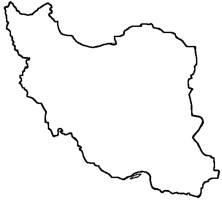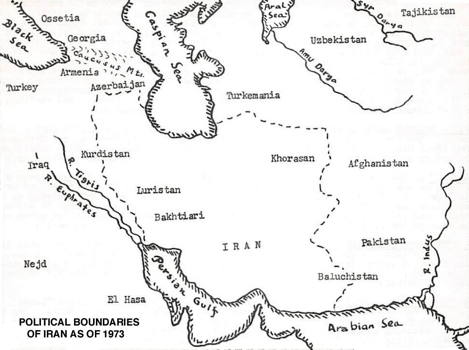
|
The Society of Folk Dance Historians (SFDH)
Iranian Dance
[
Home |
About |
Encyclopedia | CLICK AN IMAGE TO ENLARGE |

|
 When we speak of Iranian dance, the term "Iranian" covers a larger area than the present-day political configuration of Iran. Iran means "Land of the Aryan," and this is a linguistic and cultural, rather than a racial, term. The Iranian languages include Persian (Farsi), Pashto, Baluchi, Armenian, Tajik, Ossetian, and many others. For many centuries, the political and cultural centers of this vast linguistic and cultural area shifted between present-day Iran and the Soviet Central Asian area and Afghanistan. Today, when we discuss Iranian dancing, it must be understood in terms of a vast geographical area that stretches from Afghanistan and Tajikistan on the Chinese frontier all the way west to Slavic, Semitic, and Turkish areas. Needless to say, when one speaks of these areas in terms of cultural phenomena, such as dance or music, there are no hard and fast borders, such as political borders, but rather conceptual borders for purposes of analysis and research.
When we speak of Iranian dance, the term "Iranian" covers a larger area than the present-day political configuration of Iran. Iran means "Land of the Aryan," and this is a linguistic and cultural, rather than a racial, term. The Iranian languages include Persian (Farsi), Pashto, Baluchi, Armenian, Tajik, Ossetian, and many others. For many centuries, the political and cultural centers of this vast linguistic and cultural area shifted between present-day Iran and the Soviet Central Asian area and Afghanistan. Today, when we discuss Iranian dancing, it must be understood in terms of a vast geographical area that stretches from Afghanistan and Tajikistan on the Chinese frontier all the way west to Slavic, Semitic, and Turkish areas. Needless to say, when one speaks of these areas in terms of cultural phenomena, such as dance or music, there are no hard and fast borders, such as political borders, but rather conceptual borders for purposes of analysis and research.
Of all of the languages in this area, Modern Persian (Farsi), and its predecessors, Middle and Old Persian, are the most prominent, from a literary and communications vehicle, thus creating a further mode of tying together the inhabitants of this area.
The Classical Persian musical system of scales and modes (these terms are inadequate to express the way in which Iranian and other musicians from this area conceive of music, but will serve for the purposes of this article) are also still in use throughout this area today.
In order to approach Iranian dancing, we must realize that documentation and research in this area is scanty, and historical documentation is limited to impressions left by foreign travelers and observers, beginning with Herodotus, whose comments were often hostile because there was no understanding of the aesthetic standards and bases of Iranian dance forms.
In looking at Iranian dance, we must realize that there is a conceptual dichotomy between urban and rural dance forms, both in function and aesthetic concept. However, unlike most of Eastern Europe, where the urban population perform essentially alien dance forms from the West. In Iran, as in several other Oriental societies, such as Japan, Korea, India and Cambodia, urban dance forms evolved from indigenous dance forms, and in the hands of professional dancers, these forms were highly elaborated and developed.
Urban dance forms were primarily performed by soloists, but written and pictorial records indicate that group dances existed. The Qajar (18th to 19th centuries) court maintained a troupe of twenty-four dancers who executed highly sophisticated choreographies. In this, Iranian dance closely parallels Iranian music, where solo performance is more common than group work.
The phenomenon of improvisation can be likened to a language community. To everyone who speaks English there are available a reservoir of phonemes (individual sounds in a language), morphemes (single units of meaning), and a grammatical structure that enables each speaker of the language a range of possibilities for the combination of these elements to express himself or herself. But each speaker of the language has his or her own specific history and abilities, and so the range of capability runs from the Shakespeares and Jane Austins to illiterate, barely functioning speakers and users of the language. So, too, the Iranian dancer had at his or her disposal a range of movements and ways to combine them. Their success depended on how well they performed and combined these elements, how many elements they knew, and how aesthetically and emotionally satisfying they were to their viewers. Learning these elements, as with language acquisition, was done in both formal and informal learning situations.
After Islam, the social position of the professional dancers, as in other Islamic societies, was that of social pariah. The young adolescent boys and women who were professional were, almost without exception, prostitutes, which reflects accurately Islamic attitudes toward music and especially dance. Since World War II, this attitude toward those who dance in public (professional or not) has been undergoing change throughout this entire area. But negative attitudes toward dancing and those who dance still exist.
The professional dancer, in the sense we are discussing, largely disappeared as a class before and after World War I, but to this day small troupes can still be found. This disappearance caused some change in the vocabulary utilized by dancers. By and large, the idea of repetitive, intricate footwork and foot patterns, so important to the European dance forms (both ritual and urban) are not utilized in this area. The old professional dancers executed difficult acrobatic feats and often (from a Western viewpoint) grossly lascivious gestures. But since the disappearance of these dancers as a professional class, these elements are no longer, or are rarely, performed because the former require the kind of skill only a professional can master, while the latter elements are no longer of functional utility.
One may still see excellent urban dancing among non-professional performers, and, especially in the Union of Soviet Socialist Republics (USSR), among the dancers of the professional and amateur performing theater companies. In social contexts one may also see fine examples of urban dance forms by those who dance as a form of emotional and aesthetic self-satisfaction in informal gatherings. It is perhaps not so spectacular as this form was when professionals executed it, but it still affords both the participant and the observer a great deal of enjoyment.
One other essentially urban form must be mentioned in passing, and that is the movements of the so-called whirling dervishes. These men (and only men) have largely disappeared in the Iranian areas, but in this instance, dancing was less for visual effect than as a means through which the performer achieved a state of psychological and emotional ecstasy through the kinetic elements of patterned movement, for example, dance, and in order to experience contact with God. Although the function of these dances was in almost direct to opposition to the professional entertainer, Orthodox Islam frowned on the use of dance in religious contexts and so these various forms of dervish orders, regarded as heretics, were forced to cease their practices.
Urban dance forms and the movement inventory utilized by the urban dancer are quite consistent throughout this entire area, and this consistency is reflected in the classical music as well. For instance, in those areas, such as Uzbekistan, where large Turkish-speaking populations have established themselves, the dance movements have certain Mongol elements not found on the Iranian Plateau.
It should be stressed that in Iranian dances, the hand movements have no one-to-one meanings, as in the case with Indian Mudras, for example. Also, the Danse du Ventre, or "belly dance," is not part of the Iranian dance tradition and is correctly regarded by most Iranians as Egyptian.
Rural dance forms are much more varied and take on a regional character as opposed to the more universal character of urban dance forms. Some general observations can be made concerning them. In the Western areas of the Iranian Culture Area (Azerbaijan, Armenia, Kurdistan, Luristan), and the tribal groups of Western Iran (the Bakhtiari and Qashqai), group dances predominate and men and women often dance together. In these areas, the dancers hold on to one another with various handholds, often using handkerchiefs. Because of this formation, the torso and hands do not assume much importance to the performers. Repetitive foot patterns form an important element of the dance and the dances move in a similar way and together. Combat dances in which the men dance with long staves, sometimes inflicting severe blows on one another, are performed in much of this area. The most popular music is the "sorna" (double-reed instrument) and "dohol" (large drum). In the Caucasian districts, clarinet and accordion have been used for several decades. These dances generally occur outside as both the volume of the musical instruments and the number of dancers tend to be great.
In the Eastern districts of this area – Tajikistan, Afghanistan, Khorasan, Baluchistan, etc., the men and women do not generally perform together. The dances of the men and of the women, although performed in groups, find the dancers separated from one another but executing essentially the same movements. The men throughout this area execute gyrating head movements (as opposed to the intricate movements of individual facial features in urban dances). These head movements sometimes attain such an intensity that ecstasy is approached. Rapid whirling for the men is a persistent element in the dances of the Eastern dialects. Also, dances with small sticks for rhythmic purposes are performed in this area, and these dances have their analogs throughout much of Eastern Asia.
Also in this area, mimetic dances demonstrating the movements of animals, caricatures of the humans, and hunting and agricultural labor gestures, are performed. The antique dance know generally as the "hobby horse dance" is performed here as well, and this dance has been observed in many parts of the Old World since ancient times, having analogs in the areas as widespread as Asia and the Basque Country. Although the aforementioned "sorna" and "dohol" are found in the East, most dance accompaniment is provided by the "daire" (tambourine) or "dombak" (goblet drum). Dance events are more commonly held indoors because the number of dancers tends to be fewer.
Common to both rural and urban dances throughout this area is the carrying of objects, such as clappers (castanets) of wood or metal, handkerchiefs, wine glasses or hot tea cups, sticks (large and small) for making rhythm or combat, etc.
In the entire Northern tier, in such areas as Khorasan, Armenia, Georgia, Azerbaijan, and Turkmenia, men's solo virtuoso dances with acrobatic leaps and squats are very popular.
Women, in general, tend to dance in groups less than men. Their place in the dance events is parallel to the observance of Islamic and other traditional mores. Thus, in the Christian areas of Georgia and Armenia and among Moslem tribes such as the Bakhtiari and Qashqai, where traditional Islamic structures on commerce between the sexes are more loosely observed, men and women dance together, whereas in some districts the men and women do not even perform in the presence of one anther.
Since World War I, and especially accelerated after World War II, these traditional views have been breaking down and changing regarding dance, and traditional dancing is becoming an honorable and desirable activity, especially among the younger generations.
DOCUMENTS
- Anthony Shay, an article.
- Beware of Gift Giving Customs in Foreign Lands, a list.
- Beware of Your Behavior in Foreign Lands, a list.
- Iran, a country.
Used with permission of the author.
Printed in Folk Dance Scene, September 1973.
This page © 2018 by Ron Houston.
Please do not copy any part of this page without including this copyright notice.
Please do not copy small portions out of context.
Please do not copy large portions without permission from Ron Houston.
